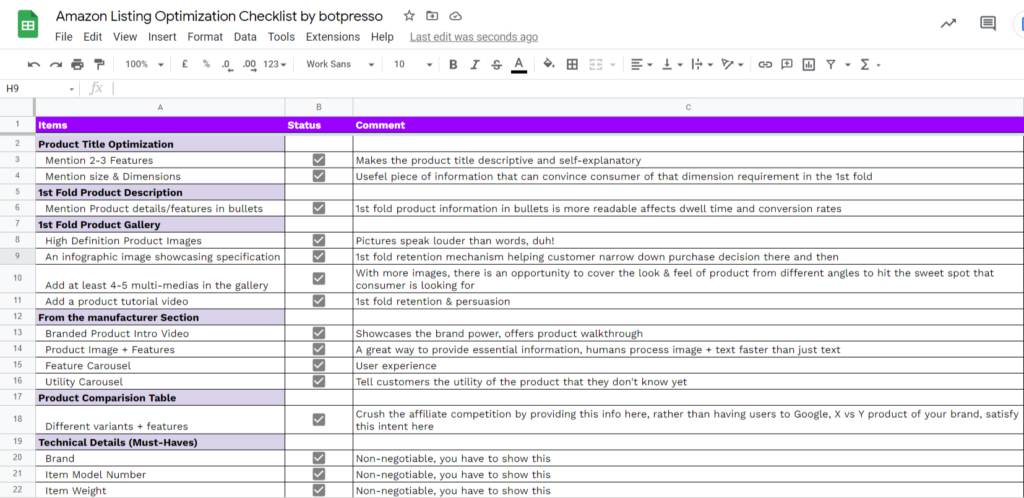What you will learn?
What is Amazon SEO?
Amazon SEO is the process of making your products rank higher on the Amazon website whenever your target audience searches for them; it is done by employing Amazon SEO best practices which we will dig into as we move further in this guide.
You may be surprised to learn about the sheer volume of searches that take place internally on Amazon. According to the data, 55% of customers start their shopping searches on Amazon. Your customers are already searching for your product on Amazon and that’s an opportunity that you can tap with proper optimization practices in place.
You don’t have to take our word, take a look at this startling screenshot from Helium10

“Card against humanity” has a search volume of 136,101 on Amazon.com USA and the number of competing products is >1000. This is the kind of potential market opportunity Amazon has most of which you can claim organically with listing optimization.
Amazon SEO encompasses not only your Amazon product listing but also what people are saying about it via Amazon reviews or other online sources.
Amazon SEO-ing your product listings can be extremely beneficial to your bottom line because Amazon holds over 50% of the e-commerce market share in North America, far surpassing eBay’s 10% and other competitors like Walmart and Rakuten (formerly Buy.com).
Not only does Amazon hold tremendous sales volume, but its conversion rate (the percentage of visitors to a site who buy something * ) is also much higher than that of other e-commerce sites. Amazon’s conversion rate is 3 times higher than the average e-commerce site and their retention rate (the percentage of shoppers that come back to Amazon to shop again * ) is over 90%.
Here are some amazing Amazon SEO Case Studies that you need to look into.
Why is Amazon SEO Important?
Amazon SEO is just as important as SEO that we do for sites. We do SEO for sites because we want to take advantage of the search opportunity that lies for the business category and we want to own all sorts of search intents like Informational intent, commercial intent & transactional intent.
Amazon has over 300 million active users worldwide. Just imagine the sheer volume of competition all the sellers are battling for.
How would consumers see your product if you don’t optimize your Amazon SEO?
For the same product search that takes place on the Amazon platform, there are thousands of sellers that are battling to rank on top to get the most customers. Being able to crack that puts you into the position to generate a lot of sales and revenue.
The purpose of Amazon SEO is to help your listings rank well, maintain their rankings and keep generating revenue.
Understanding Amazon A9 Algorithm
The A9 algorithm is used by Amazon’s internal search engine to show relevant product listings. It also affects how well (or poorly) your Amazon affiliate site ranks in Amazon’s search engine.
The A9 algorithm is also incredibly important to sellers on Amazon, who are reportedly directly involved in the setup and configuration of this algorithm.
So what does the Amazon A9 algorithm do? Let’s take a closer look…
The Amazon A9 algorithm is a self-updating, highly adaptive algorithm that determines how to rank products in Amazon’s search results. To do this, it takes into account many different elements from product reviews to pricing information. It also includes factors such as click-through rate and conversion rate, both of which are important to Amazon affiliates.
The Amazon A9 algorithm sounds similar to Google’s Panda update, right? Not exactly… While the Amazon A9 is technically an algorithm, it doesn’t use complicated mathematical formulas or require years of experience with computer science to decipher. It’s much simpler than that.
The Amazon A9 algorithm uses a large set of real-time factors to rank products in Amazon’s search engine. Things like degree of text match, price, availability, selection, and sales history.
In a nutshell, Amazon A9 is blatantly looking to increase the sales for Amazon people who come to Amazon come with an intent of purchase i.e. they come with transactional intent and this is what A9 wants to optimize the store inventory for hence it will try to rank products following that.
- Helps in finding the right users
- Acquire users in the most cost effective manner
- Increase the app’s visibility
- Reach users across the globe
- Boost organic downloads of app
What are Amazon A9 elements?
The Amazon A9 algorithm doesn’t have many elements, but the ones it uses are very important… Product title, Product images, Product bullet points, Category/subcategory Name Brands ASIN Search term.
While Amazon A9 is usually associated with Amazon affiliates, it’s used by Amazon internally to rank products in their search engine. This means that practically anyone who buys or sells products on Amazon can benefit from understanding the Amazon A9 algorithm.
Let’s see how Amazon ranks products for a competitive search term

Some observations that we can make about the 1st two organic product listings are
- Just Dance 2022 has fewer reviews than Mario Kart that is ranked at #2 which means reviews aren’t the single biggest ranking factor
- The first product is cheaper than the second product
- The first product has 2 console gaming options both Nintendo & PS4
- The first product has been posted later than the second product
- The first product is ranked #15 in Video Games Category & #2 in Nintendo Switch games
- The second product has only 14 left in stock
- The second product is more expensive than the first
- The second product ranks #62 in video games and #9 in Nintendo switch games
This analysis gives us an insight into how the A9 algorithm works on a broad level.
How to find the right keywords for your Amazon Listings?
Integrating the right keywords is an essential part of Amazon Listing Optimization because it now allows your listing to rank for all these relevant search queries around the listing that are taking place on Amazon.
There are certain ways to find the right keywords for your listing, but on the top are the ways using which you can find these nuggets from Amazon itself.
Amazon-related searches for example.

For your product there are also the set of terms users are searching for on Amazon for which your product can rank better if you add this.
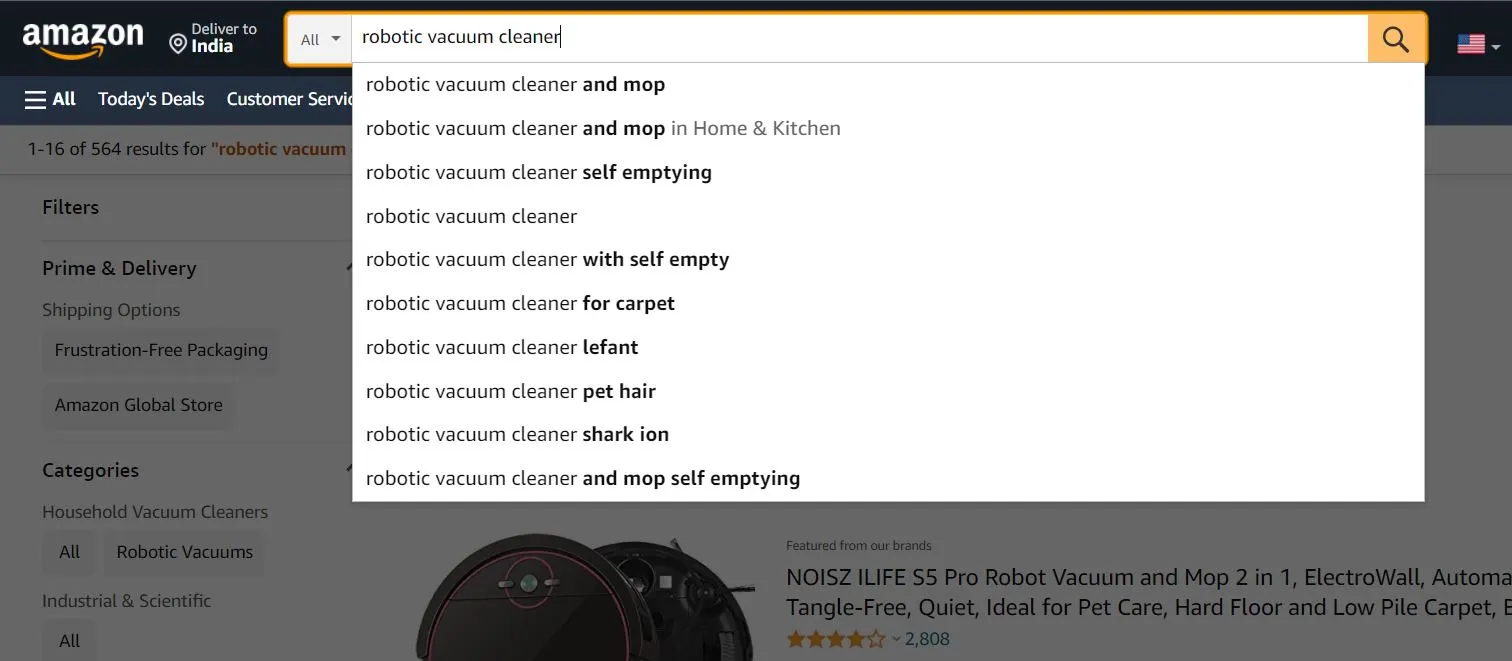
Amazon Autosuggest is also a good option to get some more ideas from Amazon that you can add in the copy as an exact match.
You can use the Helium10 Cerebro Keyword Research tool where you have to put the ASIN to get all the keywords the listing is ranking for.
Here you can get to know the relevant keywords for which your listing ought to be ranking higher but isn’t, you now have the opportunity to add those keywords.

In the above example, we can see a lot of generic keywords i.e. non-branded for which the robotic vacuum cleaner should rank on Amazon’s first page but the organic ranks are much down.
How to optimize your product listings for more organic growth?
- Optimizing Product Title
- Optimizing Product Descriptions
- Optimizing Content Structure
- Power of media in listing optimization
1. Optimizing Product Title
The thing about Amazon product titles is that they are quite descriptive. They vastly differ from the kind of product title that you would form on your D2C eCommerce website.
Here is an example:

This product title bears 14 words and 104 characters. If you think from the traditional SEO perspective then you may think that the product title is quite lengthy but here you don’t have to worry about the search engine traffic.
Your main concern lies with ranking the product in Amazon and to that end, all of your competitors, or at least most of them are packing their most important keywords in the product title.
Product title is the most important field on the product page as that is what people see first when they search for products on Amazon.
In the above example, the attributes they mention in the product title are
- Brand name
- Product type (what it is)
- Technical features (WiFi Connectivity, Self Charging)
- What it’s Good for (Pet Hair, Carpets, Hard Floor)
Some of the key points to keep in mind when drafting your product title are
- Titles must not contain promotional phrases, such as “free shipping”, “100% quality guaranteed”.
- Titles must not contain characters for decoration, such as ~ ! * $ ? _ ~ { } # < > | * ; ^ ¬ ¦
Take a look at Amazon style guides to get their recommendations
2. Optimizing Your Product Descriptions
Here we are talking about the first fold product description and how you can go about optimizing this. This part comes right at the second scroll that the user makes.
This is again a critical aspect, you need to share all the information here that is important to the user and can influence his purchase decision.
Let’s take a look at an example

In the above example, we can see that they have mentioned the following useful attributes
- Brand name
- Color
- Surface recommendation
- Controller type
- Battery cell composition
As we go down and discover about this item section, one thing to note in this is that the content is drafted in a way that would convince the users.
But it’s still not a drag for the sake of increasing the word count, all the pointers carry important points that a customer may surely take into consideration while making the purchase.
This is the section where your keyword research keywords can be incorporated, keywords that have Amazon search volume.
Content readability is an important consideration like here the lengthy product information is represented via bullet points instead of paragraphs.
3. Additional Product Information Organization
Information about the product doesn’t end with the above fold product information, provide as much information as you possibly can.
What additional information can you add?
- What’s in the box?
- Images, videos, and galleries from the manufacturer add infographics too
- Add third party reviews information here, for example, “Best Home Tech Gadget of 2021 by TheVerge”
- A dedicated section about features, break each one down with media + information snippet
- Carousel Gallery of horizontal images with text overlay information
- Another product description snippet but covering different information this time
- Product information table that can contain more information, take a look at this example

As you can see the volume of information this structured table is covering.
Amazon by default attaches the option of Q&A – make sure that you answer these questions. It is also a form of content that plays an important role in optimization.
4. Power of Media in Listing in Media Optimization
Visual Content has much more adaptability and far better information retention across consumers.
Besides, images come in the first fold without even making any scroll at all. People see the image of the product that they are looking to buy.
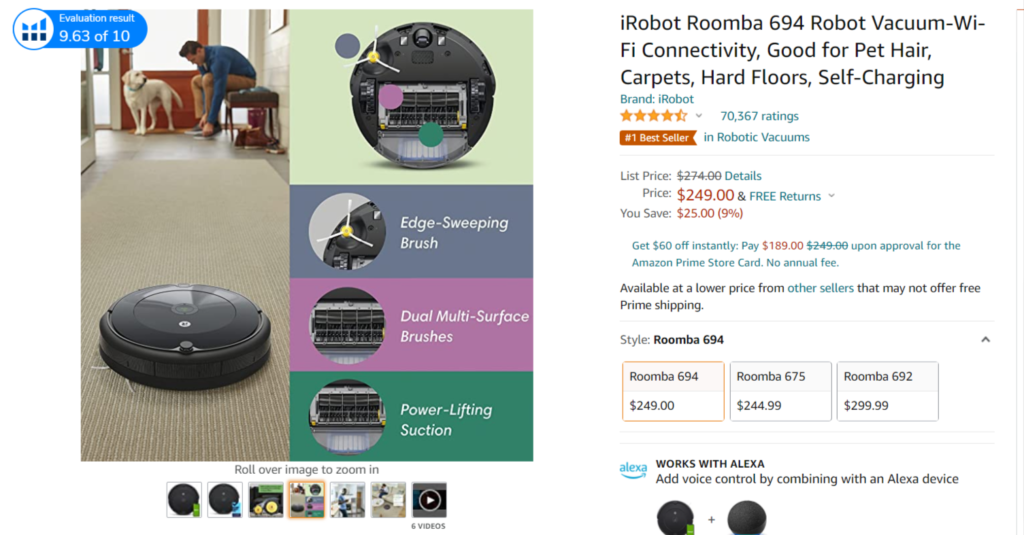
You have to cover images in the gallery from major perspectives to visually answer the questions your customers have in their minds. We are not just showing the picture of the product to demonstrate what the product looks like, here in the above example we can also see what features the product is coming with. And even the videos are added in the carousel gallery.
In the same product example as you go below you also discover a product feature illustration gallery, a video by the manufacturer, branded product photography by the manufacturer, and more.
Holistically these media make the product page complete in the way that it answers all the queries consumers have about the product.
5. The power of UGC in your listing optimization
There are 3 ways UGC are factored into Amazon product listings are
- Reviews & ratings
- Q&A
- Customers adding images in reviews
UGC undoubtedly plays a huge role in ranking your products in the Amazon search helping it obtain more visibility and sales.
As a seller you need to have a strategy in place to nurture the reviews you are getting and processes in place to tackle the negative feedback that your listing received whether it is in form of reviews or Q&A it needs to be addressed cordially.
Moreover, you can have a process in place to obtain reviews from users that are buying your products.
Anatomy of an Optimized Amazon Listing [Infographic]

How does an Amazon Seller Account Help you optimize your Amazon Listing?
Amazon Seller account has a growth opportunities section that broadly highlights aspects that are keeping your products from achieving the visibility that it deserves.

As you can see in the above screenshot it has enlisted all the opportunities that the products have, like adding A+ Content, Comparison Table & more.
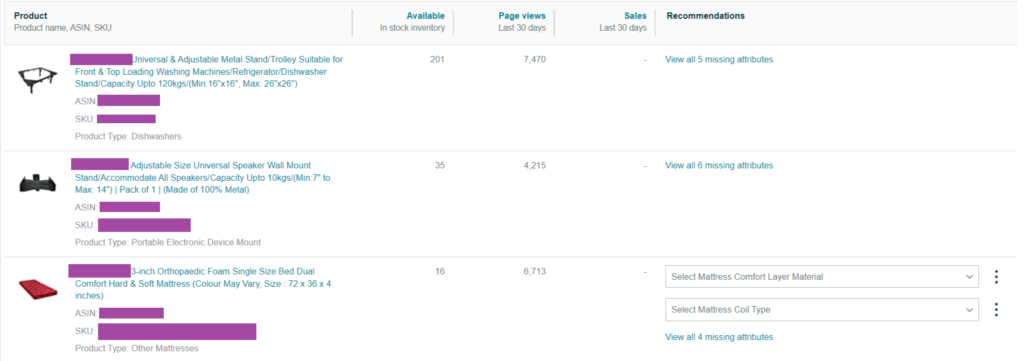
The above screenshot shows the recommendations that Amazon has got for us which will help us improve our listing performance on Amazon.
Google goes further to analyze the feedback for the app and finds the keywords. It’s a good idea to review the reviews where you can find the inspiration for the keywords.
Amazon KPIs that you need to look at
Monitoring KPIs is critical in every aspect of marketing and business in general.
Similarly here are some key Amazon Seller KPIs that you need to monitor in order to project growth and understand the brand’s performance on Amazon.
1. Profits
The first one is a no-brainer, as a seller on Amazon, you need to know what products are making profits so that you can spot your winning products and understand the patterns that make them winner products. Maybe you can take some learnings from that to incorporate the same into the products that are failing.
2. Loss
You need to track the loss-making products too. This will help you learn and get a broader understanding of products that are making losses. This data will help you optimize the expenses of your business and be more profitable in the long run. You can spot patterns like written reviews received on loss-making products, returns and refunds, and probable reasons behind that.
3. Refunds
When it comes to refunds you can track products with maximum refunds, moderate refunds, and also those with no refunds at all.
You can say that zero refund products are your winners and that people are loving it considering how much of those were sold.
And those with maximum refunds are the ones that need immediate attention. Perhaps there is some quality issue or maybe there is misleading information about the product on Amazon whatever be the case refund rates need to be optimized to keep your operations on Amazon profitable.
4. Returns
As a seller, it is important to track returns on products that are being sent back. Product returns broadly take place because of 2 reasons
- The customer wasn’t satisfied with the product he/she ordered
- The customer mistakenly ordered your product
If it is instance number one then that raises questions on the quality of the product something that needs to be fixed for long-term survival.
5. Ratings & Reviews
Ratings & reviews are direct feedback about your product that you receive from your end consumer and this part needs to be optimized well as this determines whether your product ranks well in the categories and receives the honorable badges that make your products stand out from the crowd on Amazon.
6. Conversion Rates
The conversion rate is pretty simple for Amazon, it is calculated by dividing the total sales transactions by the number of visits. As per data, the average conversion rate on Amazon is 10-15%, this survey data number can act as a threshold to see how your store’s number stacks against the industry average.

In this screenshot from the Amazon Seller account, we can see the conversion rate by ASIN & Category.
7. Badges
Badges to Amazon products act as an accolade that the listings can flaunt on Amazon and be spotted fast by the user.
Here are the badges that products can receive
- The best seller badge
- Amazon’s choice badge
- The new release badge
- The extra savings, coupons, and discount badge
Considering the way a listing performs on Amazon it receives/ earns the badge by Amazon. This is a KPI worth tracking, sellers can identify the characteristics of a best seller badge product and try to replicate that across different product listings.
How to Get an Amazon Choice Badge? Does it even matter?
For sure Amazon Choice Badge makes a ton of difference and can help your listing gain increased visibility.
There are certain things you need to do for your listing to be qualified for Amazon Choice Badge.
1. Ace your keyword research game
Figuring out the keywords that get more visibility to your products is not news. There are tools out there that help greatly with getting this data. What’s more important though is to build the correspondence between the keywords and the products that you are selling, the relevancy will help you earn that trust and visibility.
2. Customer Ratings
Customer ratings help another important criterion that helps build trust and Amazon can trust you by letting you rank higher and by providing you with a choice badge things are least likely to go south and ultimately Amazon’s sales are bound to increase.
3. Becoming Prime-eligible is mandatory
There is no way for your listing to get a choice badge if your products aren’t prime eligible. If you have hovered over the choice badge you will see it say ‘available to ship immediately’ this in turn can again help increase the sales and thus more probability of customer ratings.
4. Competitive pricing
Listings that are priced efficiently are much likelier to receive the choice badge, premium products have a lesser likelihood of the same.
How to get an Amazon Best Seller Badge?
Getting Amazon’s Best Seller Badge gives feelings of power to any Amazon Seller if you are one then I am sure that you can relate to this.
It is shiny, appealing, and definitely helps your products get the increased visibility that it deserves.
In fact, 60% of the bestsellers focus on selling products from the Home & Kitchen category.
It’s like literally Amazon is rooting for your product urging users to buy this product.
But a good question is, how do you even get the Amazon Best Seller Badge, to begin with?
Let’s first decode what Amazon Best Seller Badge is
Amazon Best Seller is a shiny badge that you see on the product, here is an example of that.

To become a best seller you need to know that in general there are 100 products in best seller for a given category and based on competition that is taking place there your product qualifies or doesn’t qualify to become a best seller labeled product.
How do you become eligible though?
In very simple terms, it means that your product has to have the most sales & rank #1 in the said product category and if that category has the best seller badge then you get that badge.
Importance of Monitoring Amazon Account Health

In a nutshell, Amazon can literally disable your account after which you can’t sell anything that’s how important it is to monitor your Amazon Account Health
What are the items that flag your Amazon Account Heath as red and put your seller account into jeopardy?
- Order defect rate
- Negative feedback
- A-Z Guarantee Claims
- Chargeback claims
- Suspected Intellectual Property Violations
- Received Intellectual Property Complaints
- Product Authenticity Customer Complaints
- Product Condition Customer Complaints
- Food and Product Safety Issues
- Listing Policy Violations
- Restricted Product Policy Violations
- Customer Product Reviews Policy Violations
- Other Policy Violations
These are the things in your Amazon Seller account that you have got to be careful about, to check the Amazon Seller Account Health you have to go to Seller Central > Performance Menu > Account Health
And this will show you what you score and what are the things that are flagged and if anything critical has been flagged.
You can also read about the Amazon SEO guide which will help in your SEO efforts
UGC an Important Element in your Amazon SEO Strategy
User-Generated Content in general plays a pivotal role in the industry of e-commerce and Amazon is no different here. Your competition can steal your customers if you are falling short of UGC.
When a customer performs a search on Amazon, he/she has an option to sort the results by the number of user ratings the product has received. That’s how important having UGC elements are for your Amazon Listing.
Types of UGC your Amazon Listing can use
1. User reviews and ratings
This is one of the most basic and useful forms of UGC your Amazon listing needs. If the number of user reviews and ratings helps your product rating reach 4.5 stars then that makes your product stand out differently than how it would appear with 3 or 2-star ratings.
Additionally, people read these reviews before making a purchase, make sure you are not buying reviews where all the reviews say the same thing making it overall look fictitious.
2. Q&A’s
Questions and Answers are an amazing feature of an Amazon listing that adds richness to the Amazon Listing.
It gives customers the ability to ask questions about your product and you have the ability to answer these questions so that other users having the same questions can find the answers.
3. Media that consumers adds to the listing
This is one of the most interactive forms of UGC that your Amazon listing can gather. The Seller adding pictures and videos about the product is one thing, but consumers adding raw images and video about the product gives a more realistic look and feel to other consumers about the product.
Because the seller is most likely to add branded photography or videography, whereas consumers would add raw content captured from their smartphones and appear more organic to users.
How can Helium10 Help you with SEO?
Helium10 is one of the best tools for Amazon that is out there which helps you accomplish a lot of things to boost your listing performance.
Here are some of the top ones.
Keyword Research
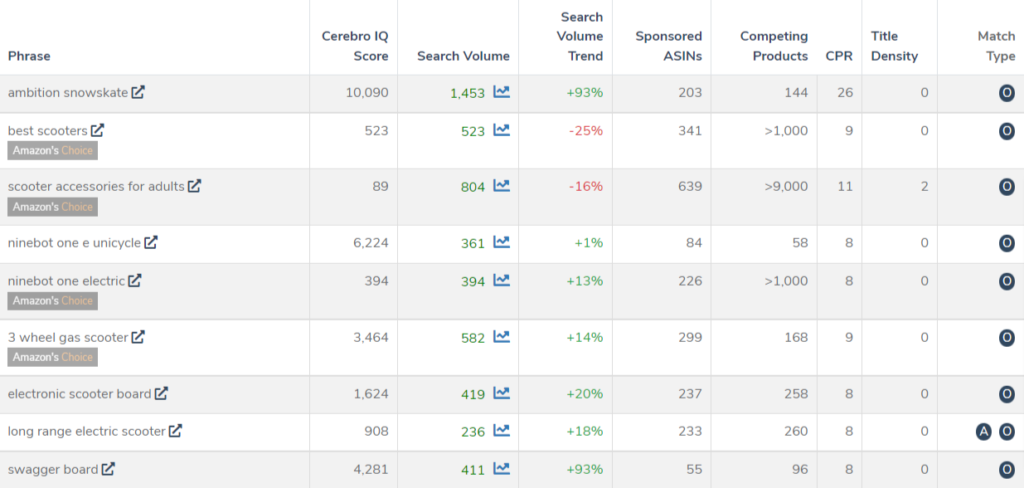
Helium10 can actually tell what is the number of searches taking place for a phrase on Amazon, what does the search trend look like, the number of competing products, and the match type.
This data can really help you with prioritizing keywords for which you should optimize your listings.
Keyword Rank Tracking
With Helium10 you can map keywords with ASIN i.e. Products and track the number of keywords it ranks for and what position. This can really help you track the improvement or decline in the rankings of keywords based on optimizations that you make.
Market Research
Using Helium10 you can conduct market research and it can provide some really intelligent data points that can add to your research and really help you make informed decisions.

Like in the above example, I have conducted market research for “Towels” and I can see what the market volume looks like and what ASIN’s i.e products are dominating the market.
Here are some more market research data that is really important for me.

Here I am getting more granular data on the market from those who are dominating it.

While doing manual market or product research on Amazon, the Helium10 chrome extension helps by conveniently showing details about the product like its ASIN, how it ranks in its category, the number of sellers for that product, and who is taking care of the fulfillment.
Product Performance

The product performance dashboard from Helium10 gives me business-level data on how things are moving. Some of the critical things to look for here are Net profit, Refunds, and no of units sold.
Do you like what Helium10 can do for you? Why not take it for a spin? There is a forever-free plan also that can help you get the hang of the tool and understand if it is for you.


